Art Painters | Music | Literature | Video | Pictures
Painters Tintoretto | Titian | Canaletto | Fortuny | Albrecht Dürer |
Canaletto Life and Career | Paintings
Paintings Grand Canal Balbi | Grand Canal Foscari | Rialto Bridge | Mendicanti | Saint-Mark | Piazzetta | Rome
Canaletto — Antonio Canal Venice Paintings (1697-1768)
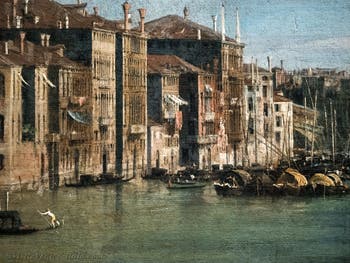
Canaletto Venice Grand Canal from Balbi Antonio Canal, known as Canaletto, “Little Canal”, was the first great painter of views of the city of Venice to associate the unique architecture of his city with the daily life of its inhabitants.
His talent and his love of Venice explain his rapid international success in his time and even today. His works are not only descriptive but also full of poetry.
His perspective is also exceptional: he does not use it to show a distant object that moves away; on the contrary, his view shows the opposite: things in the distance come closer to you!
Canaletto was like a photographer of life.
Canaletto was not only a historian of his time, nor can one limit his role to that of the city's first “photographer”.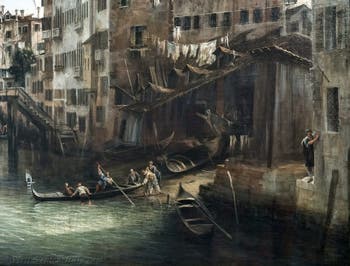
Canaletto, View of Rio dei Mendicanti Canaletto's views managed to make the heart of Venice beat in his paintings with many details and framing worthy of the most outstanding photographers.
His perfect framing, his extreme concern for constructing his paintings give them an eternal, timeless side: an ideal Venice.
We see Venice in all its architectural richness, and we feel it; it speaks to us: the Venice of the time of Canaletto is there, before us, lively, full of life. bb A gondola passes, a child plays, gossips stopped at the top of the bridge, a basket on their arm, arguing just like these nobles wearing wigs on the shore.
Meanwhile, workers put a boat in the water under the housewife's gaze leaning over her balcony above them.
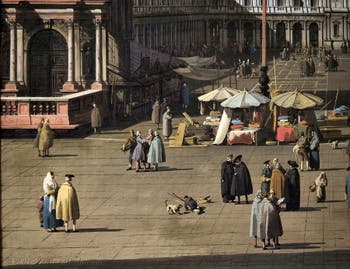
Canaletto, St. Mark's Square Procuratie Apart from the clothes, you can still see today these scenes, those busy Venetians and women chatting on the bridges or watching at their window.
Nowadays, we can see the same as those immortalized by Canaletto.
Here appears the talent of this genius, who combined precision and humanity, combining the rigour and the alignment of stones with light and the daily life of the Venetians.
The multitude of details and characters he integrates into his paintings is so well organized, so perfectly staged, so subordinated to the overall coherence of the composition that it seems even more natural and “in its rightful place”.
From the small rowing boat to the big sailboat and the gondola, all kinds of crafts come to life under the brush of Canaletto.
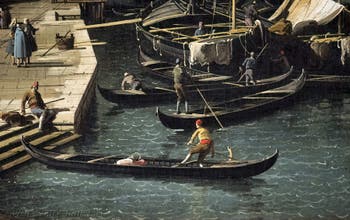
Canaletto, Venice Grand Canal Being a true child of Venice, Canaletto knew how to move a gondola forward; by a wrist rotation and a pelvis and arm movement, the oar plunged into the water, so he could hear the sound of the water gurgling along the rowing boat's hull.
Such movements can be seen in his paintings, as we hear water sounds, the noise of the steps, the cries of gondoliers on the canal and merchants on the banks or Piazza San Marco.
Canaletto's use of shadows and light is just as remarkable.
He painted shadows to model and sculpt the facades, unite them, remove some of them, bring them closer to others, and transform them into an ideal setting of Venetian life: a dream of Venice.
The ”Vedute”, an art considered minor in Canaletto's time.
Antonio Canal, nicknamed Canaletto at the age of 25, was only considered a gifted craftsman by his contemporaries.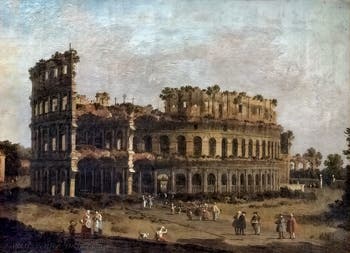
Canaletto, The Colosseum Famous painters, those recognized as such, painted only scenes recounting the significant events of history, battles and coronations, antique scenes, and, of course, religious themes.
At the beginning of the 18th century, in France or other European countries, Canaletto was at the very bottom of the hierarchy of genres in the art of painting.
Artists who painted everyday life were barely recognized as artists. Canaletto suffered the pain of this contempt for a long time, but he was happy to be considered in his time the best in his field while being disdained, ranked at the very bottom of the scale of pictorial art.
A long time later, this hierarchy would eventually be reversed with the arrival of the Impressionists.
Canaletto Forerunner of the Impressionists
In Canaletto's painting, everything is highly detailed, until the slightest slit on a wall, the tiniest piece of rope, the small floor lamp at the bottom of the painting, the little dog scratching.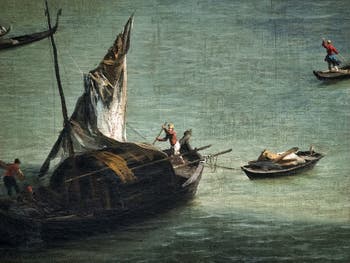
Canaletto Venice Grand Canal from Balbi And yet, his brushstroke is often a precursor to that of the Impressionists.
At first, the touches of colour breaking through the painting show the wind moving the banners and the laundry drying on the Altane (the Venetian roof terraces).
This impressionist avant-garde is also found in some characters and details, barely sketched but visible and understandable.
These housewives painted in just a few touches of colour. This gondolier, whose hat seems ready to fall into the water, is depicted with a single brushstroke of amazing simplicity yet so precise.
Canaletto is the simplification master with a few brushstrokes that draw better than the neatest drawing.
He used his skills, pictorial genius, to flood Venetians and boats with light: light is everywhere, transparent, vibrant, solar.
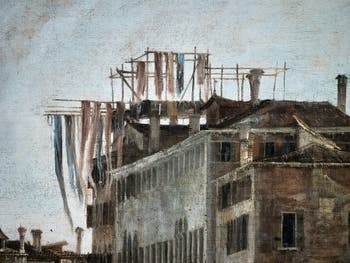
Canaletto, View of Rio dei Mendicanti Here is the sun that catches the extended linen, which hangs the white sleeve of the gondolier.
Canaletto often worked in successive layers to make the light vibrate better, give the necessary transparency to the water or the sky, use layers of paint more or less thick, painted on top of each other even before the previous ones are completely dried.
All his art translated into subtle changes of tone that you do not see immediately, but that one feels. His canvases are alive, vibrant with colours, with the last genius's touch capable of adding to it the poetry of life.
It's no coincidence that one of his greatest admirers was William Turner!
Canaletto rejected by the Accademia of Venice
The Venice Academy of Fine Arts was created in 1756 when Canaletto was already 59 years old, but when he applied at 66, he was rejected!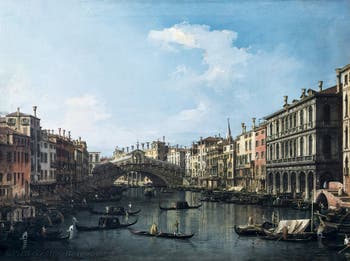
Canaletto Grand Canal and Rialto Bridge Three positions were available at the Academy following the death of three of its members.
They were assigned to three other painters unknown nowadays; Canaletto was only in the fourth position in the number of votes.
Finally, Canaletto entered the Venice Academy because one of the three new members died shortly after his election.
However, painters of views were not considered real artists. To be admitted, Canaletto had painted an imaginary landscape with ruins, a countryside alien to the colourful life of Venice.
A banal painting still exhibited at the Accademia of Venice.
Birth and vocation of Canaletto
Giovanni Antonio Canal, known as Canaletto, was born on October 28, 1697, in the parish of San Lio in the Castello in Venice.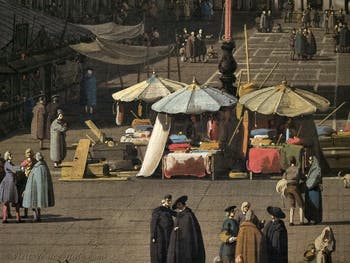
Canaletto, St. Mark's Square Procuratie He was baptized two days later.
His godfather was named Paolo Vendramin, and his godmother “la Rucchi”. His father, Bernardo Canal and his mother, Artemisia, sister of Carlo Barbieri, were from former Venetian families who owned some real estate.
But contrary to what was reported for a long time, neither was one part of the Venetian aristocracy.
Canaletto's father painted theatre sets and occasionally took care of scenography.
Therefore, it was pretty natural that he introduced his son Antonio to this type of painting, then considered a minor.
Staging and theatre sets
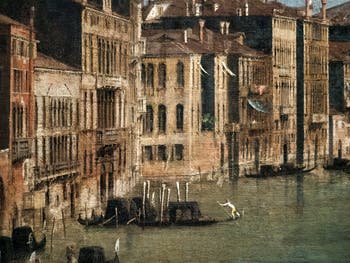
Canaletto Venice Grand Canal from Balbi From 1716 to 1718, Canaletto attended his father and uncle in Venice for the staging and setting of several shows.
Among them: “Arsilda regina di Ponto” and “L'Incoronazione di Dario” by Antonio Vivaldi.
So one can think that Antonio Canal knew Vivaldi.
He made many other sceneries during these two years, but unfortunately, no drawings, engraving or painting remained.
On the other hand, the young Antonio Canal quickly became interested in painting as art while participating with his father and uncle to produce theatre and opera sets.
Canaletto in Rome in 1719
That year, Canaletto's father received orders for sets to be made in Rome for Alessandro Scarlatti, the father of the famous composer Domenico Scarlatti.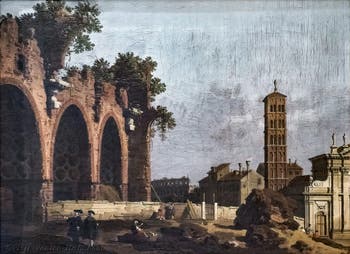
Canaletto, Roman Forum These were the sets of “Turno Aricino” and “Tito Sempronico”.
Canaletto's stay in Rome lasted almost two years. He met several artists, including the Roman Panini and the Dutch Gaspar Van Wittel, artists who helped him confirm his desire to become a painter instead of a simple set director.
During this stay, like most contemporary painters, he was seduced by the monuments and ruins of antiquity that emerged throughout Rome.
He drew and painted in the open air from the Roman forum and facing the Colosseum, which was overgrown with trees growing in the middle of the arena.
It is unknown whether Canaletto's education had given him all the necessary knowledge to fully understand the meaning and history of the ruins he painted.
Still, it was undoubtedly in Rome that his talent began to express himself, as well as his desire to become a painter of “Vedute”, painter of “views”.
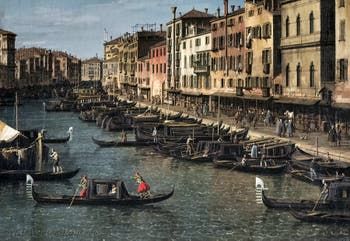
Canaletto, Venice Grand Canal These paintings nascent passion predicted his style by mixing architecture with everyday life, where small Roman characters were as present as the ruins before they were painted.
Two small paintings attributed to Canaletto, depicting the Basilica Maxentius and Constantine at the Roman Forum and the Colosseum, are exhibited at the Borghese Gallery in Rome.
It was long believed that they had been made by his nephew Bernardo Bellotto, the son of his sister Fiorenza, who had learned his trade in his uncle's studio as early as 1735.
But in recent years, this hypothesis is no longer as secure as it seemed.
Therefore, these two paintings would be Canaletto of that time or made later during a second stay; they have many similarities to Canaletto positively authenticated paintings, particularly in representing the minor characters, their gestures and attitudes, and how to deal with perspectives.
Return of Canaleto to Venice in 1720-1721
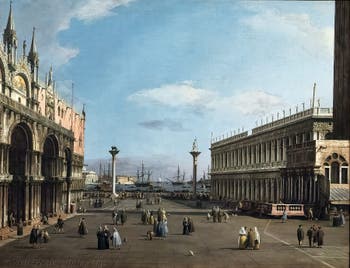
Canaletto, The Piazzetta St. Mark Canaletto's official painter career began when he entered the Venetian register of "painters of the Fraglia" Corporation in 1720.
His vocation as a painter of "Vedute" was barely confirmed that the Venetian in love with his city, whom he felt even better than Rome, had quickly started to work.
But in Venice, he was not the only painter of views of the Serenissima, Luca Carlevaris and Marco Ricci were painters in vogue for their landscapes and perspective paintings exhibited by Girolamo Molin, a wealthy Venetian.
The subtle mix of stones and men in Canaletto's paintings made the difference with those of his two competitors, quickly overshadowed by the talent and genius of the young painter of barely 23 years old.
Canaletto became an International celebrity as Painter of Views, of Vedute - Canaletto's British Collectors
Throughout his life, Canaletto's success was much more significant with foreigners, the Venetians being less sensitive, maybe jaded towards the beauties of their city.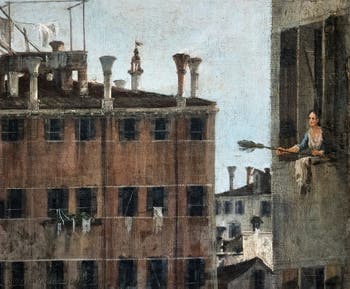
Canaletto, View of Rio dei Mendicanti In 1722, an Irish art trader living in Venice, Owen McSwiney, noticed Canaletto's talent and managed to integrate him into a project depicting the “Allegorical tomb of Lord Somers”, on behalf of Lord March, the future second Duke of Richmond.
Indeed, in a letter from McSwiney to Lord March in 1722, one finds for the first time mentioned the nickname of Antonio Canal: “Canaletto”.
“Canaletto” became his official painter's name for the rest of his career.
In 1725 Canaletto realized four views of Venice, which he delivered to a Veronese painter Alessandro Marchesini, an intermediary for Stefano Conti residing in Lucca, near Pisa.
In 1726 he received an important commission from Jacques Vincent Languet, France's new ambassador to Venice.
Joseph Smith, the turning point of Canaletto's career
Joseph Smith, art lover consul of England in Venice, had also noticed Canaletto's talent and entered into a contract with him to sell his paintings to the British.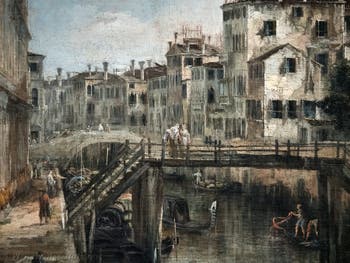
Canaletto, View of Rio dei Mendicanti But Smith was not only acting out of love for art; Canaletto was for him a particularly lucrative business that lasted nearly 20 years.
Not only did he buy all Canaletto's paintings at a low price as they were produced, and he had him sign a contract under which all his new paintings would be sold exclusively to him!
Smith made huge profits by selling the paintings to wealthy Englishmen at prices incommensurate with Canaletto's.
However, even though Canaletto was this fool's bargain prisoner for more than ten years, his reputation was made in England thanks to Joseph Smith.
He had now become a famous painter in high demand, so much so that he could no longer produce enough to meet all the orders received by Smith, a good opportunity for Smith to increase prices again!
In London, everyone was crazy for his paintings, often considered "exotic", sometimes bought by people who had never even set foot in Venice.
It was also the same Joseph Smith who further increased Canaletto's prestige by selling, in 1762, his collection of works by Antonio Canal to King George III of England: 49 paintings, 143 drawings and 46 sketches.
Works that are still part of the British Royal Collections and are preserved at Windsor Castle.
Canaletto: too expensive!
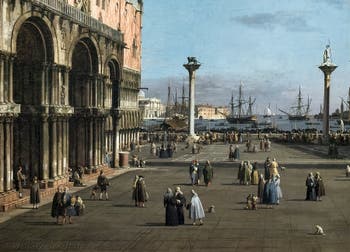
Canaletto, The Piazzetta St. Mark The outbid developed by Joseph Smith meant that, apart from the richest, no one could buy a Canaletto any longer.
The Frenchman Charles de Brosses witnessed this:
For the Canaletto, his job is to paint views of Venice: in this genre, it surpasses everything there has ever been.
His way of work is light, vivid, cheerful, perspective and admirable detail.
English collectors spoiled this artist so well, offering his paintings three times more than he asks that it be no longer possible to market with him.”
Charles de Brosses
Sales of Canaletto's paintings declined from 1740 when the British got difficulties with travelling because of the Austrian succession war after the death of Emperor Charles VI.
Falling in commissions, Canaletto left Venice for London
Having fewer and fewer orders and probably tired of Smith's exploitation, Canaletto decides to go to London to find new customers for himself.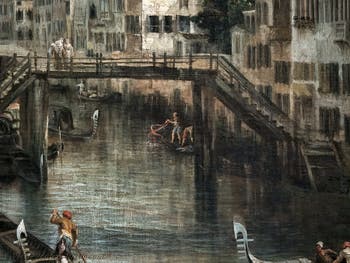
Canaletto, View of Rio dei Mendicanti Upon arriving in London, he was first confronted with numerous false paintings signed by his name, proving his success, subsequently giving him an unexpected disappointment.
He stayed in London from 1746 to 1755, but he wasn't a hit with collectors, so he left disappointed, just as many Englishmen were with his “English Vedute”.
Canaletto committed the mistake of painting the City of London with his Venetian eye. A city he didn't know, a city so different from his own.
English collectors were as much in love with Canaletto's talent as to its marvellous subject: Venice.
You can feel Canaletto's love for Venice in his paintings, but how he painted London in his early English beginnings is much colder.
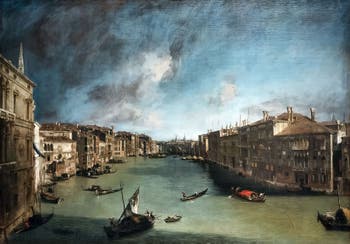
Canaletto Venice Grand Canal from Balbi The technique may be perfect, but the spark of genius is non-existent; life is not there; they are just good frozen “photos”.
How could he regain the light, the reflections of the Grand Canal of Venice in the waters of the Thames?
As a result, the English were disappointed by Canaletto's first London works, and some even began to doubt his identity.
Very negative comments then began to run the streets of London: “This man who claims to himself Canaletto is just an impostor!”
Canaletto was stung to the quick, reacting with pride to this insult.
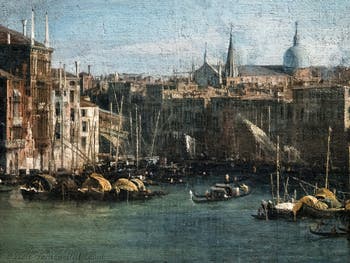
Canaletto Venice Grand Canal from Balbi Nevertheless, he was obliged to publish an announcement inviting the artistically competent people to visit Mr Riccardo Wiggan's house at Silver Street, where he then lived, to see his last work, which represented a view of St. James Park.
A wise reaction on his part, since this announcement invitation, the accusations of imposture ceased.
During these years, Canaletto found buyers for his views of London and England, getting just enough money to live there, nothing more.
He poorly withstood London's icy fog while homesickness took him.
Therefore he returned to Venice in 1755 and lived here until he died in 1768.
Canaletto back to Venice
Being ten years away from Venice was undoubtedly a mistake.According to some critics, even though his stay in London allowed him to refine and complete his palette and technique, his works will never be of the same level again after returning to Venice.
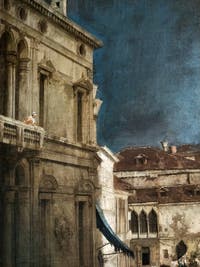
Grand Canal from Balbi Therefore, orders also seemed to be less numerous.
But the fault may not be due solely to Canaletto because the fashion of the paintings of view was passing at that time, and other painters have begun to take his place during his long absence.
Canaletto's golden age had passed, it had also aged, and, even though in a drawing from the interior of St Mark's Basilica of 1766, Canaletto proudly wrote: “executed without glasses”, the said drawing, although meticulous, already reflects too much the mannerism of his last years as a painter.
Two years later, after five days of fever, on April 19, 1768, at seven o'clock, Canaletto died at 70 in his house on Calle de la Malvasia in Castello, Venice number 5485.
Calle de la Malvasia lies between Salizada San Lio (then go under the Sotoportego to Corte Perina) and the Malvasia Bridge.
However, no one has found his grave.
Canaletto and the use of Camera Oscura, the Darkroom
It is known that Canaletto used Camera Oscura, the ancestor of SLR and photography.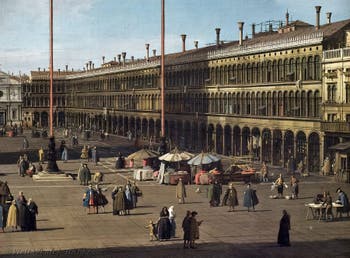
Canaletto, St. Mark's Square Procuratie Francesco Algarotti describes the “Camera Oscura” as follows:
“The lens receives these rays that emanate from external objects, unites them, and transmits them within the Camera Oscura, in the same order, and in the same situation as the points of the objects from which they departed.
And these rays, like so many brushes, reflect the image of these different objects on a sheet of paper, which was put at some distance from the lens.
The painter then draws with a pencil on the paper the image that the Camera Oscura drew there.”
Francesco Algarotti
However, Canaletto did not use it to slavishly copy the image as some did, but only to better render the perspective, the mathematical part of his painting.
A few years ago, we found in the storeroom of the Correr Museum a dark room with the inscription “A. Canal”, which in all likelihood was that of Canaletto, Antonio Canal.
Canaletto seen by the writer Henri de Régnier
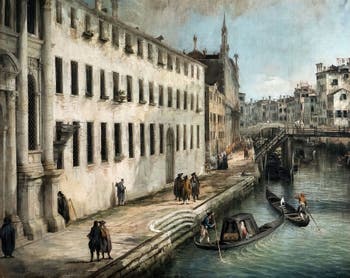
Canaletto, View of Rio dei Mendicanti
“The reputation of a Canaletto was considerable and exceeded the territory of the Serene Republic. Deserved fame. Canaletto is a master.
Its views of Venice are admirable. In the magnificent Venetian light, Venice appears to us in its most meticulous accuracy.
The accuracy of the outlook is complemented by the precision of the details.
It is the perfection of art that rules, such as mathematics, maintain the truth of reality.
Some significant themes dominate, some favourite aspects are repeated, which were probably the most demanded by amateurs.
Canaletto met these demands with a kind of masterful ease, a kind of quiet indifference.
This good painter seems to accomplish by painting a function to which he is docile.
The beauty offered to him by the face of Venice, he strives to restore it with all his nobility and grace.
In this way of responsibility, Canaletto shows no apprehension or fatigue. On the contrary, it starts again with an equal concern for perfection.
His brush and art are infallible.”
Henri de Régnier — Venetian Life
Canaletto Life and Career | Paintings
Paintings Grand Canal Balbi | Grand Canal Foscari | Rialto Bridge | Mendicanti | Saint-Mark | Piazzetta | Rome
Painters Tintoretto | Titian | Canaletto | Fortuny | Albrecht Dürer |
Art Painters | Music | Literature | Video | Pictures
Back to Top of Page

